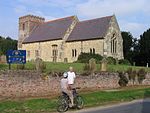East Riding of Yorkshire

The East Riding of Yorkshire, often abbreviated to the East Riding or East Yorkshire, is a ceremonial county in the Yorkshire and the Humber region of England. It borders North Yorkshire to the north and west, South Yorkshire to the south-west, and Lincolnshire to the south across the Humber Estuary. The city of Kingston upon Hull is the largest settlement. The county has an area of 2,479 km2 (957 sq mi) and a population of 600,259. Kingston upon Hull is by far the largest settlement, with population of 267,014, and is a major port and the county's economic and transport centre. The rest of the county is largely rural, and the next largest towns are the seaside resort of Bridlington (35,369) and the historic town of Beverley (30,351). The county is governed by two unitary authorities, East Riding of Yorkshire Council and Hull City Council. It takes its name from the East Riding, a historic subdivision of Yorkshire. In the east of the county the low-lying plain of Holderness is enclosed by a crescent of low chalk hills, the Yorkshire Wolds. The Wolds meet the sea at Flamborough Head, a chalk headland, while the Holderness coast to the south is characterised by clay cliffs. The west of the county is part of the Vale of York, the wide plain of the River Ure/Ouse; the south-west is part of the Humberhead Levels.
Excerpt from the Wikipedia article East Riding of Yorkshire (License: CC BY-SA 3.0, Authors, Images).East Riding of Yorkshire
Lund Road,
Geographical coordinates (GPS) Address Nearby Places Show on map
Geographical coordinates (GPS)
| Latitude | Longitude |
|---|---|
| N 53.916666666667 ° | E -0.5 ° |
Address
Lund Road
Lund Road
YO25 9SJ , Lockington
England, United Kingdom
Open on Google Maps











